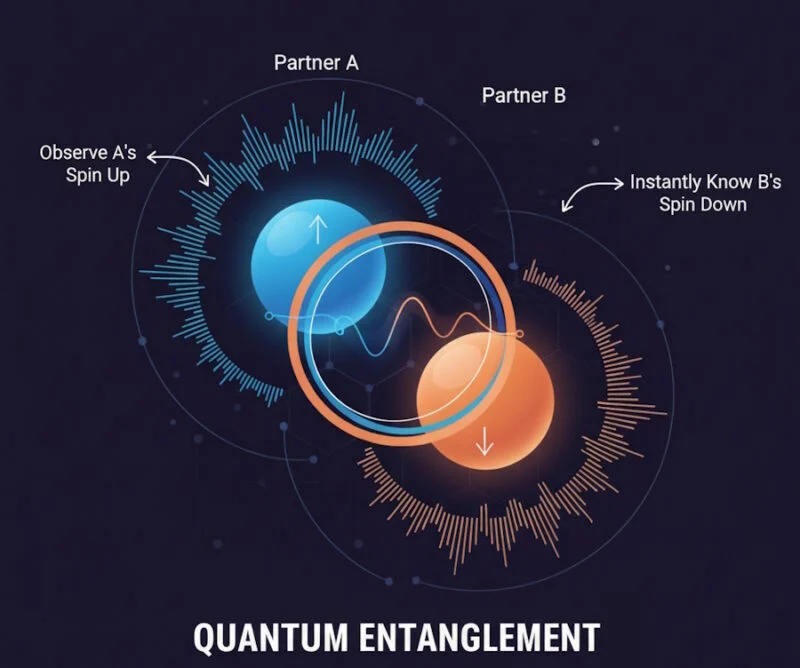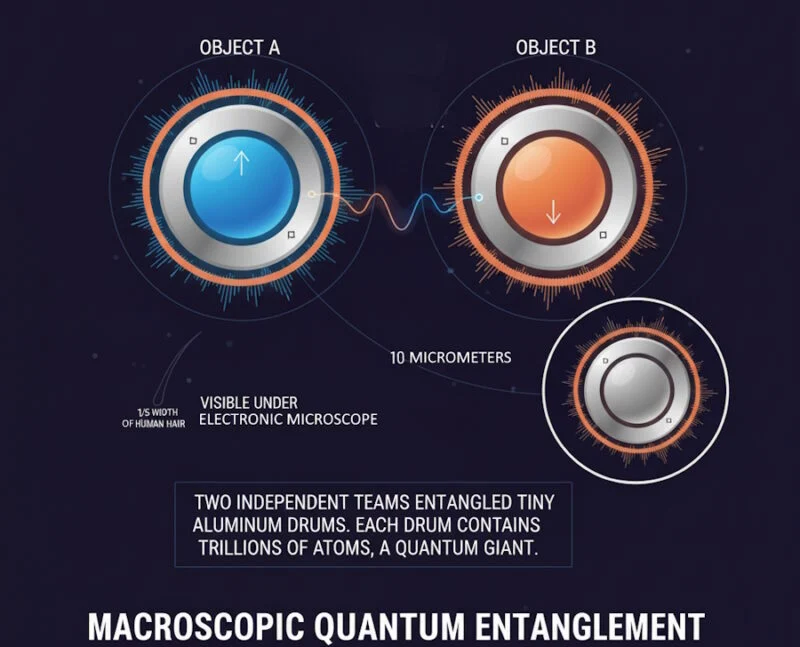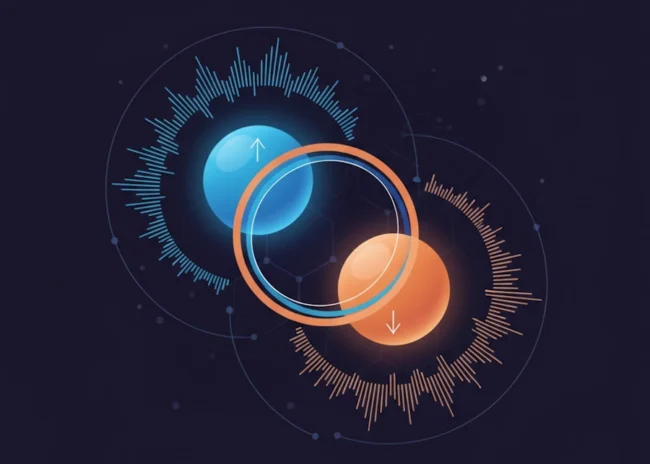Einstein called it “spooky action at a distance,” and for good reason. Quantum entanglement stands as one of the most counterintuitive phenomena in modern physics, a reality so strange that even the brilliant minds who discovered it spent decades arguing over what it meant.
The basics: what is quantum entanglement?
At its core, quantum entanglement occurs when two or more particles become linked in such a way that the quantum state of each particle cannot be described independently. Even when separated by vast distances, measuring one particle instantaneously affects the state of the other.
This isn’t science fiction—it’s been repeatedly confirmed through experiments and earned its discoverers the 2022 Nobel Prize in Physics.
The phenomenon raised from a famous 1935 paper by Einstein, Podolsky, and Rosen (EPR), who thought they had found a fatal flaw in quantum mechanics. They argued that if quantum theory were complete and respected locality (the principle that objects are only influenced by their immediate surroundings), then distant particles shouldn’t influence each other. Since quantum mechanics predicted they would, Einstein believed the theory must be incomplete.
He was wrong, but spectacularly so. Decades of experiments have confirmed that nature really does behave this non-local way.
When particles become entangled, they form a unified quantum system where measuring properties of one particle—like its spin or polarization—immediately determines the corresponding property of its partner, regardless of the distance between them.
How does it actually work?
The mechanism behind entanglement comes down to quantum superposition and measurement. Before measurement, entangled particles exist in what physicists call a superposition state—they occupy multiple states simultaneously. The particles don’t have definite properties until someone measures them.

When scientists create entangled photons, for example, they might generate pairs where one photon has vertical polarization and the other horizontal, or vice versa. But crucially, before measurement, each photon exists in a superposition of both polarizations at once. Only when you measure one photon does the superposition “collapse,” fixing its state and simultaneously determining the state of its partner.
This process has been described using quantum field theory, where researchers model entangled systems as inequivalent representations of vacuum states.
The mathematics reveals that entanglement creates long-range correlations between particles, introducing ordered patterns that can persist even in noisy environments under specific conditions.
Bringing entanglement to the macro world
For most of quantum mechanics’ history, entanglement remained confined to the microscopic realm—photons, electrons, atoms. The hot, noisy environment of everyday life seemed fundamentally hostile to such delicate quantum effects.
That changed dramatically in 2021. Two independent teams succeeded in quantum-mechanically entangling macroscopic objects for the first time. These weren’t individual particles but tiny aluminum drums—mechanical resonators measuring about 10 micrometers across, visible under an electron microscope. While still small by everyday standards (about one-fifth the width of a human hair), these objects contain trillions of atoms, making them giants in quantum terms.

The experiments by teams at Aalto University and NIST overcame tremendous technical challenges. The physicists had to cool these drums to near absolute zero and isolate them from environmental vibrations. They generated entanglement through different methods—one team used specially chosen resonant frequencies to eliminate noise, while the other created entanglement resembling a two-qubit gate where the entangled state depended on the drums’ initial states.
The achievement earned recognition as Physics World’s 2021 Breakthrough of the Year, not just for technical prowess but for pushing the boundary between quantum and classical physics. Scientists had previously observed quantum properties in individual drumheads, like achieving quantum ground states. Entangling two of them represented a leap forward.
Even bigger: Over 200 atomic ensembles in a crystal, each with billions of thulium atoms, were entangled by storing a single photon across them. This created a delocalized excitation, re-emitted as an echo, with contrast measurements proving multiparty entanglement. Top quarks at the Large Hadron Collider showed spin entanglement at high energies, the heaviest particles yet. These aren’t everyday objects— they’re cooled to near absolute zero and isolated—but they blur the quantum-macro line.
What makes macroscopic entanglement so important? These entangled resonators could serve as quantum sensors or nodes in quantum networks. The research opens possibilities for studying the fuzzy border between quantum and classical physics, addressing fundamental questions about why our everyday world appears classical despite being built from quantum components.
The consciousness question: are our thoughts entangled?
This brings us to perhaps the most controversial question: Could quantum entanglement explain consciousness? Could it mean our thoughts or emotional connections with others involve quantum effects?
The answer remains one of the biggest open questions in neuroscience and physics. The debate centers on whether the brain operates purely through classical neural signaling or whether quantum processes play a functional role.
The case against quantum brain processes
Physicist Max Tegmark famously calculated that quantum coherence in neurons would last less than a trillionth of a second—far too brief for neurological processes that take milliseconds or longer. The brain appears “too wet, warm, and noisy” for delicate quantum states to survive. Most neuroscientists work within the framework that consciousness arises from classical processes: neurons firing, neurotransmitters releasing, synaptic connections forming and strengthening.
The case for quantum processes
However, some researchers argue that neurons themselves might be too slow to account for certain aspects of consciousness. The “binding problem” in neuroscience asks how the brain creates unified conscious experiences from information processed in widely separated brain regions.
When you see a red ball bouncing, your brain processes color in one area, motion in another, and shape in yet another—but you experience these as a single, unified object. How does this integration happen fast enough?
Standard neural communication through synapses operates on millisecond timescales. Some scientists propose that faster, quantum-level processes might provide the binding mechanism that classical neuroscience struggles to explain.
Matthew Fisher suggested that certain molecules called Posner molecules might protect quantum states for hours through nuclear spins.
A 2024 study found that drugs binding to microtubules—protein structures inside neurons—delayed unconsciousness in rats under anesthesia, supporting the idea that consciousness might involve quantum processes in these structures.
Stuart Hameroff and Roger Penrose have long proposed that microtubules harbor quantum coherence. Recent research has found quantum vibrations in microtubules and evidence that anesthetics, which eliminate consciousness, disrupt these quantum states.
Some experiments have even shown that different isotopes of lithium, which have different nuclear spins affecting quantum decoherence times, produce different effects on consciousness-related behaviors in animals.
Proponents also point to growing evidence that quantum coherence can persist in warm, noisy biological environments longer than Tegmark’s early calculations suggested. Studies of photosynthesis have revealed quantum effects operating at room temperature in living systems. If evolution found ways to harness quantum mechanics in plants, perhaps it did so in brains as well.
What about emotional connections?
What about the sense that we’re “in sync” with someone, or that we have inexplicable connections with loved ones? Can entanglement explain these experiences?
Here the scientific consensus is clearer: no. Emotional connections between people have well-understood (for now) explanations in psychology and neuroscience—mirror neurons, empathy circuits, learned social behaviors, unconscious behavioral mimicry. We don’t need quantum entanglement to explain why close friends finish each other’s sentences or why couples develop similar mannerisms. These phenomena arise from social learning, shared experiences, and the brain’s remarkable ability to model other minds.
Even if quantum processes operate within individual brains, there’s no plausible mechanism for quantum entanglement between separate people’s neurons. The environmental noise that makes quantum coherence difficult within one brain would make it virtually impossible between brains.
There’s an important distinction worth noting. Some psychologists and cognitive scientists use quantum-inspired mathematical frameworks to model decision-making, perception, and memory. These “quantum cognition” approaches borrow concepts like complementarity and non-commuting operations from quantum physics.
What entanglement actually teaches us
The real implications of quantum entanglement are profound enough without adding speculative elements. Entanglement challenges our basic assumptions about reality—that objects have definite properties independent of observation, that influences propagate through space, that the universe consists of separate objects with independent existence.
Experiments have confirmed that entangled particles violate Bell inequalities, mathematical limits that any local realistic theory must obey. Nature consistently exceeds these limits, forcing us to abandon either locality or realism (or both). The correlations between entangled particles are stronger than anything classical physics permits, yet they remain bounded by what’s called the Tsirelson bound.
This has practical consequences. Quantum entanglement enables quantum cryptography, where eavesdropping is physically detectable. It makes possible quantum computing, where entangled qubits can explore multiple solutions simultaneously. It allows quantum teleportation, where quantum states (though not matter or information) can be transferred between locations using entanglement and classical communication.
Perhaps most intriguingly, macroscopic entanglement experiments suggest that quantum weirdness persists at larger scales than previously thought possible. The boundary between quantum and classical behavior remains fuzzy, subject to ongoing exploration. Each advance in isolating quantum systems from environmental noise pushes that boundary further.
The bottom line
Quantum entanglement is real, thoroughly tested, and genuinely bizarre. Particles separated by cosmic distances remain connected in ways that Einstein found deeply troubling but that experiments consistently confirm.
The phenomenon has moved from pure physics into engineering, with entanglement-based technologies emerging from laboratories into practical applications. Scientists have even managed to entangle macroscopic objects containing trillions of atoms, pushing quantum behavior into a realm where we can almost see it.
Whether quantum processes, including entanglement, play functional roles in consciousness remains an open scientific question. Traditional neuroscience has successfully explained many aspects of brain function through classical processes, but puzzles remain—particularly the binding problem and the speed of certain cognitive operations. Some researchers argue these puzzles might require quantum explanations, and there’s emerging experimental evidence that quantum processes occur in microtubules and may be disrupted by anesthetics.
The honest answer is that we don’t yet know. The brain might operate entirely through classical means we haven’t fully understood, or it might exploit quantum effects in ways we’re just beginning to discover. Both possibilities remain on the table, and both would be remarkable—one for the sheer computational power of classical neural networks, the other for evolution’s ability to harness the strange rules of quantum mechanics.
What we can say with confidence is that quantum entanglement reveals a universe stranger than our everyday intuitions suggest. Whether that strangeness extends into our own consciousness is a question that current research is actively exploring, and the answer, whatever it turns out to be, will reshape our understanding of both mind and matter.

Leave a Reply